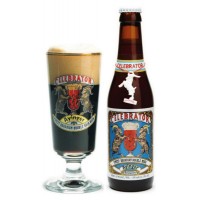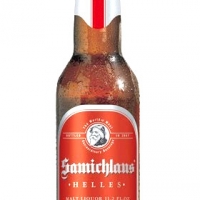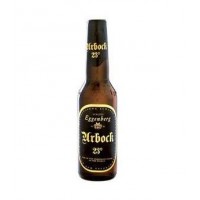Comprar Ayinger Celebrator - Schloss Eggenberg Samichlaus Helles - Schloss Eggenberg Urbock 23º
Ayinger Celebrator Doppelbock
A beer that has a dominant malty taste. This beer’s origins in a monk’s recipe are reflected in its heartiness. The Pope of Beers, Conrad Seidl, describes it as: “Almost black with a very slight red tone, a sensational, festive foam and truly extraordinary fragrance that at first summons up visions of greaves lard. The first taste is of mild fullness with an accompanying coffee tone, which becomes more dominant with the aftertaste. There is very little of the sweetness that is frequently to be tasted with doppelbock beer.” The Ayinger Celebrator has been ranked among the best beers of the world by the Chicago Testing Institute several times and has won numerous medals.
------------------------------------------------
Lager Doppelbock Bock Tostada. El color es caoba profundo con reflejos rojo rubí. Presenta espuma sólida. Aroma a nuez y un toque de cedro. Notas tostadas. Sabor mucho cuerpo. Tostado, afrutado a malta.
El Beerpope Conrad Seidl, la describe de la siguiente manera: "Casi negro, con tono ligeramente rojizo, una espuma sensacional, sólida y un olor muy raro, que recuerda a la primera manteca.
Celebrator Ayinger se ha clasificado en varias ocasiones por el Instituto de Pruebas de Chicago en el número de las mejores cervezas del mundo y ha ganado numerosas medallas.
Schloss Eggenberg Samichlaus Helles
Schloss Eggenberg Urbock 23º
Se elabora exclusivamente con materias primas naturales siguiendo la ley de pureza de 1516.
Es una de las cervezas más fuertes del mundo. Tiene un proceso de maduración, en bodega, durante 9 meses, tiempo en el cual la cerveza se oscurece ligeramente. En alguna ocasión se ha llamado el "Coñac de las cervezas".
- La Monastil Negra Caramelo - Lluna Blonde Ale - Birra & Blues La Rubia
- Heineken - Dos Equis (XX) Lager Especial - Amstel
- Negra Modelo - Gallo / Famosa - Moza
- Mahou Cinco Estrellas - Estrella Galicia Especial
- Cazurra IPA - Gredos Cerveza & Whisky de Malta - Cordobeer Ipa Santa Ana 2013
- Orval - Palm Hop Select - Mulhacén Belgian Pale Ale Ecológica
- Compañia Cervecera Kunstmann Valdivia Pale Lager - Cusqueña Dorada Golden Lager
- Cigar City Jai Alai - Westbrook Märzenbier - Flying Dog Snake Dog
- Virtus Pilsen - Garage Beer Co Backup Dancer - 4 Alqueries La Mar
- La Grúa Irish Red Ale - Nordeste - La Grúa Hops & Cops - La Grúa Viento Gallego
- Spigha Coffee Porter - La Cabra del Maresme Porter - Alter Brewing Clock Tower
- Espina de Ferro Summer Division - Baró De Savassona Rossa - Gargola Purins
- Caracole Ambrée - Lupulus Hibernatus - Me Echó la Burra Rubia
- La Calavera Simone - Young´s Double Chocolate Stout - Laugar / Mad Brewing Coffee Brain
- Domus Aurea - Cerveza Castellana Ahumada - Calles de Toledo Doce Cantos
- Estrella Galicia Especial - Estrella de Levante Clásica - Cruzcampo Radler
- Cruzcampo Pilsen - Cruzcampo Cruzial
- Brugs Tarwebier / Blanche de Bruges - Gordon Finest Silver - Vander Ghinste Cuvée des Jacobins Rouge
- De la Senne Zwarte Piet - Chimay Grande Réserve (Blue) - Cantillon Lou Pepe Gueuze
- Glops Rossa - Abadía de Aribayos Z Rubia - La Quince More Brutal Than Session
- Koenigsbier Premium Quality Beer - Alhambra Especial - Cruzcampo Fresca
- La Calavera Bretta Nojingo - XaBier’s L’Andragó - Vandals Amber Ale
- Ginesart Raure - Picarda Pale Ale - Villa de Madrid Chula Negra
- Maeloc Sidra Extra Ecológica - Maeloc Hard Cider Sweet / Sidra Dulce - Maeloc Sidra con Fresa
- Spigha Brown Ale - Acacia Burdeos - Rivvo de Ogga Cantaloupe
- ABK Hefeweizen Anno 25 - Santa Pau White Riot - Baridana de Blat
- Jupiler - De Ryck Arend Dubbel - 3 Fonteinen Hommage
- De Bie Helleketel - Gouden Carolus Classic - Leffe Rituel 9
- Kozel Premium - Wolfram Rubia - La Pedriza Pilsen
- Stella Artois - Negra Modelo - Modelo Especial
- Tecate - Cerveza Sol
- Montseny Lupulus - Moritz - Murphy’s Irish Red
- Milana Trigo - Nómada Untitldead - 90 Varas KM. 100
- Belzebuth 13° - Murex Pasas Triple Malta - Granizo Quercus
- Mahou Cinco Estrellas - Estrella Galicia Especial - Amstel Clásica
- Davok English Barleywine - Beer Here Yule Ale - CREW Republic X 2.1 Barley Wine
- Te Deum Amber - Viven Imperial IPA - Floris Fraise
- Pol Nostrum Ale - Garagart Gorritxo - 976 Negra
- Brobarnia Oktoberfest - Quiteña Munay - Andes Aniversario IPA
- BrewDog Alice Porter - Brewdog Dogma
- Ayinger Celebrator - Ayinger Maibock - Ayinger Bairisch / Bavarian Pils
- Voll-Damm - La Trappe Dubbel
- St. Peter’s Indian Pale Ale - St. Peter’s Best Bitter - St. Peter’s Crafted Black IPA
- Bayura 1893 - Lindemans Kriek - Boon Framboise
- Dawat 2 - St. Peter’s Best Bitter - Wychwood Piledriver Status Quo
- Estrella Galicia 1906 Reserva Especial - La Milnueve - Paulaner Hefe-Weißbier / Hefe-Weizen / Weissbier - Augustiner Lagerbier Hell
- Estrella Galicia Especial - Corona Extra - Medalla Light
- Marz Jungle Boogie - Goose Island Sofie - Goose Island Goose IPA
- Leffe Royale - Grimbergen Optimo Bruno - Moinette Ambrée
- Damm Lemon - Amstel Radler
- Gallo / Famosa - Cerveza Sol
- El Águila - Victoria Málaga - Alhambra Especial
- Mahou Cinco Estrellas - Victoria Málaga - Cruzcampo Cruzial
- Turia - Estrella Damm - Ambar 10
- Paulaner Hefe-Weißbier / Hefe-Weizen / Weissbier - ABK Jubiläums Pils 1907 - Stone Berlin / Garage Beer Co Cosmic Island
- Lindemans Gueuze - St. Bernardus Tripel - Préaris Quadrocinno
- La Pirata Súria - Menduiña Lobishome Sin Gluten - Žatec Celia
- Nómada Marabunta - Mikkeller Crooked Moon Tattoo dIPA - Mikkeller I Beat YoU
- Alhambra Reserva 1925 - Picarda Monegre - Damm Complot IPA
- Áncora Indian Pale Ale - Basqueland The Captain - Alkimia Hechicera

















